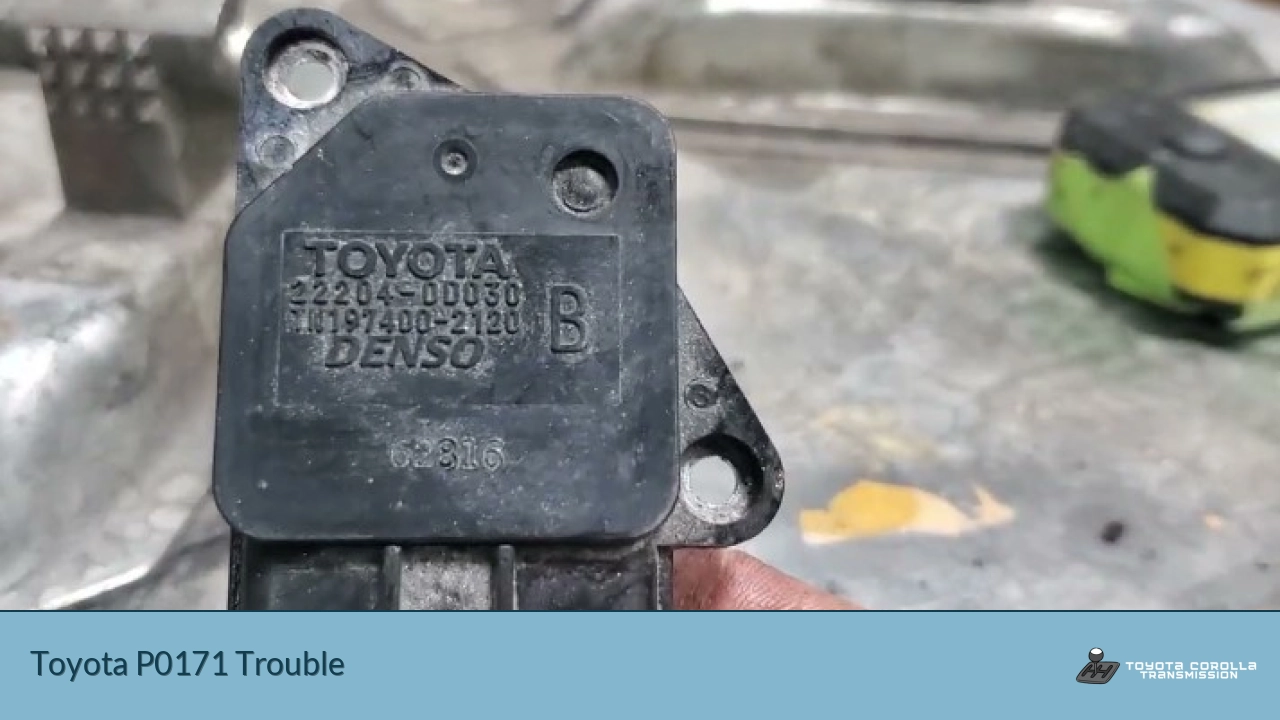The P0171 code is a common issue that Toyota owners may encounter, signaling a lean air-fuel mixture in the engine’s bank 1. This diagnostic trouble code (DTC) can be a source of frustration for many drivers, as it often leads to decreased performance and fuel efficiency. Understanding the causes, symptoms, and solutions for this code is crucial for maintaining your Toyota’s health and avoiding costly repairs down the line.
| Aspect | Description | Potential Causes |
|---|---|---|
| Definition | System too lean, bank 1 | Intake/exhaust leak, faulty MAF sensor |
| Severity | Moderate to High | Fuel pressure issues, worn injectors |
| Common Symptoms | Rough idle, poor acceleration | Vacuum leaks, oxygen sensor malfunction |
Understanding the P0171 Code
The P0171 code indicates that the engine control module (ECM) has detected a lean condition in bank 1 of the engine. This means that there’s too much air or not enough fuel in the combustion process, leading to an imbalanced air-fuel ratio. In Toyota vehicles, this code is often associated with various components of the fuel and air intake systems.
What Does “Bank 1” Mean?
In the context of the P0171 code, “bank 1” refers to the side of the engine that contains cylinder number 1. For most Toyota models with inline engines, this encompasses all cylinders. However, in V-shaped engines, bank 1 typically refers to one side of the engine block.
Common Causes of P0171 in Toyota Vehicles
Several factors can trigger the P0171 code in your Toyota:
1. Vacuum Leaks
Vacuum leaks are one of the most frequent culprits behind the P0171 code. These leaks allow unmetered air to enter the engine, disrupting the carefully calibrated air-fuel mixture. Common sources of vacuum leaks include:
- Cracked or damaged vacuum lines
- Worn intake manifold gaskets
- Faulty PCV valve
2. Mass Airflow (MAF) Sensor Issues
The MAF sensor plays a crucial role in measuring the amount of air entering the engine. When it malfunctions, it can send incorrect data to the ECM, resulting in an improper air-fuel mixture. MAF sensor problems can stem from dirt accumulation or electrical faults.
3. Fuel System Problems
Issues within the fuel system can lead to insufficient fuel delivery, causing a lean condition. Potential fuel system problems include:
- Clogged fuel injectors
- Weak fuel pump
- Restricted fuel filter
4. Oxygen Sensor Malfunction
Faulty oxygen sensors can provide inaccurate readings to the ECM, leading to incorrect adjustments in the air-fuel mixture. Over time, oxygen sensors can become contaminated or wear out, necessitating replacement.
Symptoms Associated with P0171
When your Toyota experiences a P0171 code, you may notice several symptoms:
- Rough idle or stalling: The engine may run unevenly or stall, especially when idling.
- Decreased fuel efficiency: A lean condition often results in increased fuel consumption.
- Reduced engine performance: You might experience a lack of power, particularly during acceleration.
- Check Engine Light: The most obvious sign is the illumination of the check engine light on your dashboard.
- Hard starting: In some cases, the engine may be difficult to start or require multiple attempts.
Diagnosing and Fixing P0171 in Your Toyota
Addressing the P0171 code requires a systematic approach:
Step 1: Verify the Code
Use an OBD-II scanner to confirm the P0171 code and check for any additional codes that might provide more context.
Step 2: Inspect for Vacuum Leaks
Carefully examine all vacuum lines, the intake manifold, and gaskets for signs of wear or damage. Use a smoke machine if available to detect small leaks.
Step 3: Check the MAF Sensor
Inspect the MAF sensor for dirt or debris. Clean it using a specialized MAF sensor cleaner if necessary. If cleaning doesn’t resolve the issue, consider replacing the sensor.
Step 4: Examine the Fuel System
Check fuel pressure and inspect fuel injectors for clogs or leaks. Ensure the fuel filter isn’t restricted and the fuel pump is functioning correctly.
Step 5: Test Oxygen Sensors
Use a multimeter or specialized oxygen sensor tester to verify the proper functioning of the sensors. Replace any faulty sensors as needed.
Step 6: Clear the Code and Test
After addressing potential issues, clear the code using an OBD-II scanner and test drive the vehicle to see if the problem persists.
Preventing Future P0171 Codes
To minimize the risk of encountering the P0171 code in your Toyota:
- Adhere to regular maintenance schedules, including timely replacement of air and fuel filters.
- Use high-quality fuel and consider periodic fuel system cleaning.
- Address any check engine lights promptly to prevent minor issues from escalating.
- Regularly inspect vacuum lines and connections for signs of wear or damage.
FAQs
What does the P0171 code mean for my Toyota?
The P0171 code indicates a lean air-fuel mixture in bank 1 of your Toyota’s engine, potentially caused by vacuum leaks, sensor issues, or fuel system problems.
Can I drive my Toyota with a P0171 code?
While you can drive short distances, it’s not recommended for extended periods as it may cause damage to your engine or catalytic converter.
How much does it cost to fix a P0171 code?
Repair costs can vary widely, ranging from $50 for a simple vacuum leak fix to $500 or more for major component replacements like a fuel pump or MAF sensor.
Will a P0171 code clear itself?
The code may clear temporarily if the issue resolves, but it will likely return unless the underlying problem is addressed.
How long does it take to diagnose and fix a P0171 code?
Diagnosis typically takes 1-2 hours, while repair time varies depending on the cause, ranging from 30 minutes for simple fixes to several hours for complex issues.

